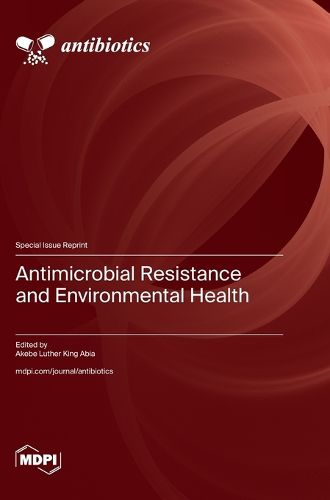Readings Newsletter
Become a Readings Member to make your shopping experience even easier.
Sign in or sign up for free!
You’re not far away from qualifying for FREE standard shipping within Australia
You’ve qualified for FREE standard shipping within Australia
The cart is loading…






This title is printed to order. This book may have been self-published. If so, we cannot guarantee the quality of the content. In the main most books will have gone through the editing process however some may not. We therefore suggest that you be aware of this before ordering this book. If in doubt check either the author or publisher’s details as we are unable to accept any returns unless they are faulty. Please contact us if you have any questions.
This reprint comprises 11 articles addressing diverse aspects of the environmental dimension of AMR. It provides a comprehensive update on antimicrobial resistance and environmental health. One article reviewed the impact of tetracycline pollution on AMR in the environment and its ripple effect on ecological and human health. The authors further evaluated possible remediation strategies for tetracycline-polluted environments. If not addressed, environmental antimicrobial pollution could lead to the development of new AMR traits and the evolution of already existing ones in different environmental matrices, as reviewed by another chapter in this volume. Two articles address the presence and transmission of AMR fomites in households and vegetables in farms. Still focusing on unconventional environmental settings, one article provides a perspective on elucidating the role of bioaerosols on AMR transmission. Two other articles discuss AMR in wastewater, one in clinical and community settings, and the other reviewed wastewater AMR in Africa while pointing out the knowledge gaps and suggesting a future perspective for the successful application of the wastewater-based epidemiology of AMR. Two articles used genomic approaches to provide insight into environmental AMR, including in the marine environment. Finally, one article proposed a community-focused framework measuring One Health drivers of AMR as an approach to promote building "antibiotic-smart communities".
$9.00 standard shipping within Australia
FREE standard shipping within Australia for orders over $100.00
Express & International shipping calculated at checkout
This title is printed to order. This book may have been self-published. If so, we cannot guarantee the quality of the content. In the main most books will have gone through the editing process however some may not. We therefore suggest that you be aware of this before ordering this book. If in doubt check either the author or publisher’s details as we are unable to accept any returns unless they are faulty. Please contact us if you have any questions.
This reprint comprises 11 articles addressing diverse aspects of the environmental dimension of AMR. It provides a comprehensive update on antimicrobial resistance and environmental health. One article reviewed the impact of tetracycline pollution on AMR in the environment and its ripple effect on ecological and human health. The authors further evaluated possible remediation strategies for tetracycline-polluted environments. If not addressed, environmental antimicrobial pollution could lead to the development of new AMR traits and the evolution of already existing ones in different environmental matrices, as reviewed by another chapter in this volume. Two articles address the presence and transmission of AMR fomites in households and vegetables in farms. Still focusing on unconventional environmental settings, one article provides a perspective on elucidating the role of bioaerosols on AMR transmission. Two other articles discuss AMR in wastewater, one in clinical and community settings, and the other reviewed wastewater AMR in Africa while pointing out the knowledge gaps and suggesting a future perspective for the successful application of the wastewater-based epidemiology of AMR. Two articles used genomic approaches to provide insight into environmental AMR, including in the marine environment. Finally, one article proposed a community-focused framework measuring One Health drivers of AMR as an approach to promote building "antibiotic-smart communities".